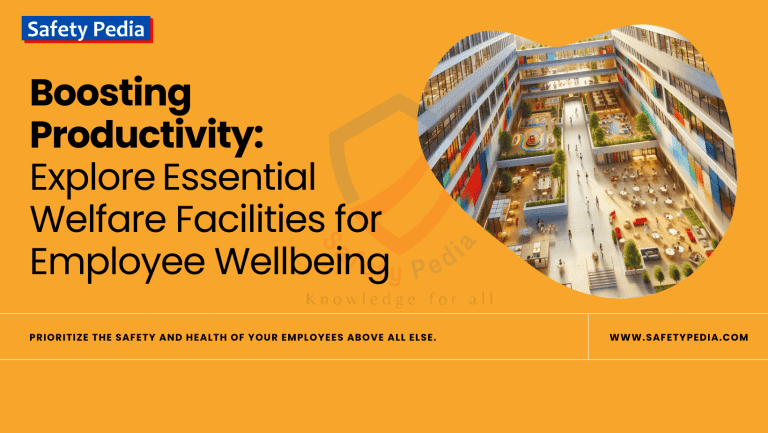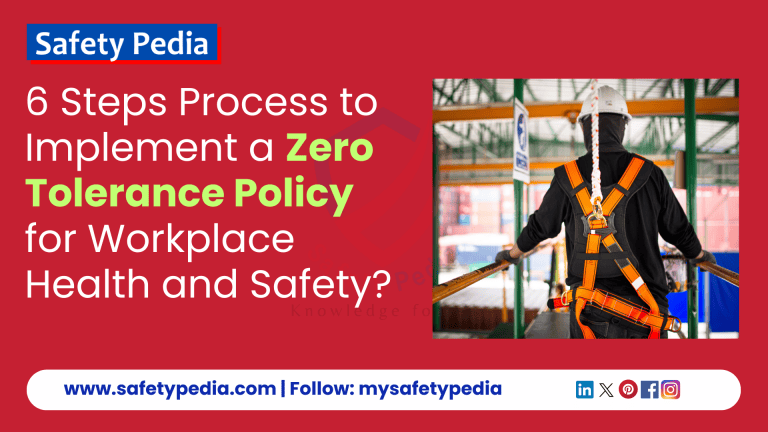
Introduction
In today’s rapidly evolving workplace landscape, prioritizing employee safety and well-being has become more critical than ever. Reporting workplace hazards is crucial in ensuring a safe working environment for all employees. By reporting potential hazards promptly, individuals can help prevent accidents, injuries, and even fatalities.
Effective reporting of workplace hazards allows employers to take immediate action and implement preventive measures to mitigate risks. This protects employees’ physical well-being and nurtures a positive and supportive work culture. Employees who feel comfortable and secure in their workplace are likelier to be loyal, engaged, and productive.
Additionally, we will discuss the potential consequences of neglecting to report hazards, including increased liabilities and damaged reputation.
Moreover, reporting hazards is not just the responsibility of management or safety officers. It is a collective effort that every employee should actively participate in. By encouraging a culture of transparency and open communication, organizations can empower their workforce to identify and report hazards promptly.
This article will explore the importance of reporting workplace hazards, its impact on employee safety and well-being, and how organizations can cultivate a reporting culture. Together, we can create safer and healthier work environments for everyone involved.
The Importance of Workplace Safety
Workplace safety is of critical importance for organizations to thrive and succeed. It protects employees from harm and safeguards the organization from potential liabilities and legal consequences. A safe work environment encourages trust, enhances morale, and improves productivity. Employers prioritizing workplace safety demonstrate their commitment to their employees’ well-being and create a positive work culture.
The Importance of Reporting Safety Hazards
Safety hazards can pose significant risks to individuals and communities. It is essential to report safety hazards promptly to prevent accidents and injuries. By reporting hazards, you contribute to the well-being of those around you and help create a safe environment for all.
When safety hazards go unreported, they can escalate into more significant issues, potentially causing harm to individuals and property. By reporting hazards, you play an active role in preventing accidents and maintaining a safe environment. Reporting hazards also shows your commitment to the well-being of others and encourages a culture of responsibility and accountability.
Reporting workplace hazards is not just about fulfilling legal requirements but also about caring for the people who drive your organization’s success. By actively encouraging and promoting a culture of reporting hazards, you demonstrate your commitment to the well-being of your employees and create a positive work environment.
Furthermore, reporting safety hazards allows authorities and relevant stakeholders to act appropriately. This ensures the necessary measures are implemented to mitigate risks and prevent future incidents. Remember, your report could catalyze positive change and increased safety.
Types of Safety Hazards
Safety hazards can take various forms, and it is crucial to understand the different types to report them effectively. Here are some common types of safety hazards:
- Physical Hazards: These hazards include slippery floors, exposed wiring, broken equipment, or objects that can cause tripping or falling. If not addressed promptly, physical hazards can lead to accidents, injuries, and even fatalities.
- Chemical Hazards: Chemical hazards can arise from exposure to toxic substances, flammable materials, or improper handling of chemicals. These hazards can result in health issues, fires, explosions, or environmental damage.
- Biological Hazards: Biological hazards can come from exposure to bacteria, viruses, fungi, or other microorganisms. This includes situations such as contaminated food, unsanitary conditions, or exposure to infectious diseases.
- Ergonomic Hazards: Ergonomic hazards are related to the design and arrangement of workspaces and equipment. Poor ergonomics can lead to musculoskeletal disorders, repetitive strain injuries, or discomfort in the workplace.
- Psychological Hazards: Psychological hazards can result from workplace bullying, harassment, stress, or other factors that negatively impact mental health and well-being. These hazards can affect job satisfaction, productivity, and overall mental and emotional well-being.
Understanding the different types of safety hazards enables you to identify and report them accurately. It is important to observe your surroundings and recognize potential dangers to ensure a safe environment for all.
Understanding Workplace Hazards
Before we explore the significance of reporting workplace hazards, it is crucial to understand what constitutes a hazard. A workplace hazard refers to any condition, substance, or activity that can cause employees harm, injury, or illness. Hazards can range from physical hazards, such as slippery floors or faulty machinery, to chemical hazards, like toxic substances, and even ergonomic hazards related to poor workplace design or improper lifting techniques.
Recognizing and identifying workplace hazards is the first step in preventing accidents and injuries.
Employees should be trained to spot potential hazards and report them promptly to the appropriate authorities. Doing so creates a safer work environment for themselves and their colleagues.
Here are some real-time examples of workplace hazards that necessitate reporting:
- Slips, trips, and falls: Wet floors, uneven surfaces, loose cables, or poor lighting can pose immediate tripping hazards. Reporting such issues allows for prompt cleaning, repairs, or adjustments to prevent potential injuries.
- Electrical hazards: Exposed wires, faulty equipment, or overloaded circuits pose a severe risk of electrical shock or fire. Immediate reporting is crucial to avoid potential electrocution or property damage.
- Falling objects: Unsecured tools or materials stored at height, unstable scaffolding, or weak overhead structures pose a significant risk of falling objects. Reporting such hazards allows for proper securing or removal to prevent potential head injuries.
- Chemical spills: Leaking containers, improper storage, or mishandling of hazardous chemicals can lead to exposure risks through inhalation, skin contact, or ingestion. Prompt reporting allows for safe containment and cleanup to prevent health hazards.
- Ergonomic hazards: Poorly designed workstations, repetitive tasks, or heavy lifting can lead to musculoskeletal disorders like back pain or carpal tunnel syndrome. Reporting such issues allows for ergonomic assessments and adjustments to prevent long-term health problems.
- Machine guarding issues: Unguarded moving parts, malfunctioning safety features, or improper use of machinery pose serious risks of entanglement, amputation, or crushing injuries. Reporting such issues allows for repairs, training, or operational changes to ensure safe use.
- Violence or threats: Workplace violence, harassment, or bullying can create a physically and emotionally unsafe environment. Reporting such incidents allows for investigation and appropriate action to protect employees’ well-being.
Remember, even seemingly minor hazards can have serious consequences if left unaddressed. Reporting promptly allows for timely intervention and prevention of potential accidents or harm.
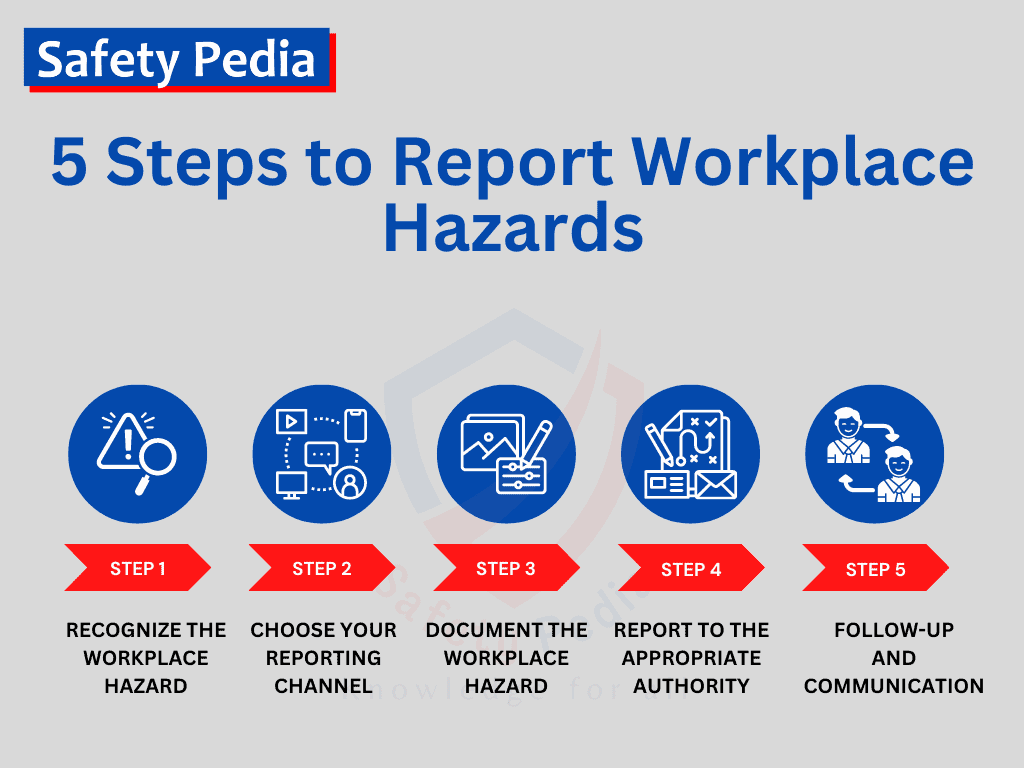
Reporting Workplace Hazards: Step-By-Step Guide
Ensuring a safe workplace is a shared responsibility between employers and employees. Reporting potential health and safety hazards is critical to maintaining a secure work environment. A proactive approach to hazard reporting can significantly reduce the risk of workplace injuries and promote a safety culture.
This guide provides a step-by-step approach to effectively report workplace hazards, drawing on best practices and expert advice.
Step 1. Recognize the hazard:
The first step in hazard reporting is to recognize a potential source of harm. Train employees to identify potential hazards in their work environment. Please encourage them to be vigilant and observant, paying attention to physical and environmental factors that could pose a risk.
Regular risk assessments, inspections, and consultations with workers can aid in identifying hazards that may include physical, chemical, biological, or psychological elements.
- Be clear about what the hazard is. This includes its type (physical, chemical, biological, psychological), specific location, and how it could potentially cause harm.
- Note any existing safety measures in place related to the hazard.
How to Identify and Assess Safety Hazards
Identifying and assessing safety hazards is a crucial step in reporting them effectively. Here are some tips to help you identify and assess safety hazards:
- Be observant: Pay attention to your surroundings and look for anything that seems out of place or potentially dangerous. This includes physical hazards such as loose cables, spills, damaged equipment, and other types of hazards.
- Review safety protocols and guidelines: Familiarize yourself with safety protocols and guidelines specific to your environment, the workplace, a public space, or any other setting. This knowledge will help you identify hazards that may violate these protocols.
- Seek information from experts: Consult with safety professionals or authorities who can guide hazard identification and assessment. They can offer specialized knowledge and help you understand potential risks more accurately.
- Use checklists and risk assessment tools: Utilize checklists and risk assessment tools provided by relevant organizations or authorities. These resources can help you systematically identify and evaluate hazards based on predetermined criteria.
- Consider past incidents and near misses: Learn from past incidents and near misses to identify recurring safety hazards. Analyze the root causes of these incidents and look for patterns or common factors that can help you spot potential hazards.
You become essential to the reporting process by actively identifying and assessing safety hazards. Your diligence and attention to detail contribute to the overall safety of your environment.
Step 2: Choose Your Reporting Channel:
Once you have identified a safety hazard, promptly report it to the appropriate authorities. Reporting hazards ensure they are acknowledged, assessed, and addressed on time. Utilize the reporting systems, whatever is available, as they are, to streamline the process and ensure proper documentation.
- Formal Reporting System: Many companies have dedicated platforms for hazard reporting, such as online portals or suggestion boxes. Utilize these designated channels.
- Supervisor/Safety Representative: Directly report the hazard to your department’s supervisor or safety representative.
- Anonymous reporting hotline: This option can encourage participation in situations where employees fear retaliation.
- Union representatives: If your workplace has a union, they can strongly advocate for addressing safety concerns.
- External regulatory bodies: Reporting to relevant government agencies may be necessary in cases of severe hazards or lack of internal action.
Step 3. Document the workplace hazard:
Once a hazard is identified, employees should document it in detail. This includes noting the location, description, the potential harm it may cause, and any other relevant information that can help address the issue. Optionally:
- You may explain how the hazard could cause injury, illness, or other negative consequences. This might involve potential accidents, exposure to harmful substances, or psychological distress.
- If possible, suggest potential solutions for addressing the hazard. This could be installing additional safety measures, implementing procedural changes, or providing proper training.
Gather Evidence: This can help illustrate the problem and aid in its resolution. If others have observed the hazard or near misses, note their perspectives and experiences.
- Take Photos or Videos: If possible, capture visual evidence of the hazard. This can help illustrate the problem and aid in its resolution.
- Document Witness Accounts: If others have observed the hazard or near miss, note their perspectives and experiences.
Documenting workplace hazards is a crucial step in risk management, but the process doesn’t stop there. To truly create a safety-focused environment, these documented hazards should be actively integrated into your company’s safety protocols. Here’s how:
1. Risk Assessments:
- Hazard Identification: Regularly review documented hazards and incorporate them into your risk assessments. This ensures a comprehensive evaluation of potential dangers in the workplace.
- Risk Prioritization: When assessing risks, consider the documented hazards alongside existing identified risks. Prioritize based on severity, likelihood of occurrence, and the number of people exposed.
2. HSE (Health, Safety, and Environment) Training:
- Case Studies: Use documented hazards as real-life case studies during HSE training sessions. This allows employees to learn from past incidents and identify potential hazards in their own work areas.
- Hazard Awareness: Integrate specific documented hazards into training modules to raise awareness about common risks and preventative measures.
3. Method Statements:
- Operating Procedures: Regularly review and revise operating procedures to incorporate control measures for documented hazards.
- Hazard Mitigation Strategies: When revising or creating method statements for specific tasks, incorporate control measures to address documented hazards. This ensures safe work practices are clearly outlined before work begins.
- Emergency Response Plans: Documented hazards that pose a potential for emergencies should be factored into your emergency response plans.
4. HSE Document Updates:
- Living Documents: Treat your HSE documents, including risk assessments, training materials, and method statements, as evolving resources. Regularly update them to reflect newly documented hazards and any changes in the workplace.
- Revision Schedule: Establish a clear schedule for reviewing and revising HSE documents. This ensures ongoing relevance and effectiveness.
Hazard Reporting Template

Step 4. Report to the appropriate authority:
Once a hazard is documented, knowing the appropriate person or department to report to is essential. Employees should know the designated person or department responsible for receiving hazard reports. This could be a direct supervisor, safety officer, or a designated health and safety representative within the organization.
Clear communication is vital when reporting a hazard. Ensure the report is understandable and includes all necessary details to facilitate prompt action.
If possible, keep a record of your report, including the date, time, and details of what you communicated. If you haven’t received a response within a reasonable timeframe, politely inquire about the status of your report and any actions being taken.
Here are the steps to follow when reporting a safety hazard:
- Determine the responsible authority: Identify the appropriate authority or organization to report the hazard to. This could be your supervisor, a designated safety officer, a government agency, or a specific department responsible for safety in your area.
- Gather relevant information: Collect as much information as possible about the hazard before making your report. This includes the location, hazard description, potential risks, and supporting evidence such as photographs or witness statements.
- Follow reporting procedures: Familiarize yourself with the reporting procedures established by the responsible authority. This may involve filling out a specific form, submitting an online report, or contacting a designated hotline. Adhere to the instructions to ensure your report is appropriately documented and tracked.
- Provide clear and concise details: When reporting the hazard, describe clearly and concisely. Please provide accurate details about the nature of the hazard, its location, and any potential risks it poses. Use specific language and avoid exaggeration or speculation.
- Follow up on your report: After making your report, follow up with the responsible authority to ensure that your concerns are being addressed. If necessary, provide additional information or clarification to support the resolution process. Persistence can be key to prompt action being taken.
Remember, reporting safety hazards is a proactive step toward creating a safe environment. Your report can prevent accidents and protect the well-being of those around you. Following the appropriate reporting procedures ensures that your concerns are heard and addressed.
Step 5. Follow-up and communication:
After reporting the hazard, follow up to ensure the report has been received and actions are taken to address the issue. This may involve checking in with the person or department to which the hazard was reported.
In a better way, employees should be informed about the actions taken and the progress made in addressing the issue. This transparent communication builds trust and encourages further reporting.
The Role of Reporting Workplace Hazards
Reporting workplace hazards is a vital aspect of maintaining a safe working environment. When employees promptly report hazards, employers can immediately implement preventive measures. This proactive approach helps mitigate risks and prevents accidents or injuries from occurring in the first place.
By reporting hazards, employees become active participants in the safety process, enabling a culture of accountability and collective responsibility. It also empowers them to contribute to the overall well-being of their colleagues and the organization.
The Role of Management in Addressing Safety Hazards
Management is crucial in addressing safety hazards and ensuring a safe working environment. Here are some key responsibilities of management in addressing safety hazards:
- Establishing a safety culture: Management should promote a safety culture within the organization. This includes setting clear expectations, providing adequate resources, and actively encouraging employees to report hazards and near misses.
- Providing training and education: Management should ensure that employees receive proper training and education on recognizing and reporting safety hazards. This empowers employees to play an active role in maintaining a safe environment.
- Regular inspections and risk assessments: Management should conduct regular and risk assessments to identify potential hazards. This proactive approach allows them to address hazards before they cause accidents or injuries.
- Prompt action on reported hazards: When hazards are reported, management should take prompt action to investigate, assess, and address them. This includes implementing appropriate controls, communicating with employees, and monitoring the effectiveness of the solutions.
- Continuous improvement: Management should promote a culture of continuous improvement in addressing safety hazards. This involves analyzing incident reports, identifying trends, and implementing corrective measures to prevent similar hazards from occurring in the future.
Management plays a vital role in creating a safe working environment by fulfilling their responsibilities. They set the tone for safety and provide the necessary support to address hazards promptly and effectively.
Benefits of Reporting Workplace Hazards
The benefits of reporting workplace hazards extend beyond preventing accidents and injuries. Employees who feel heard and supported are more likely to be engaged and productive. Reporting hazards encourages trust and confidence in the organization’s commitment to employee safety and well-being. This, in turn, leads to increased employee morale and job satisfaction.
Furthermore, reporting hazards helps organizations identify patterns and trends in workplace safety. By analyzing the reported hazards, employers can uncover underlying issues and implement corrective measures proactively. This continuous improvement approach not only enhances employee safety but also contributes to the overall efficiency and effectiveness of the organization. Here’s a comprehensive list of benefits of reporting workplace hazards:
- Prevents Accidents: By identifying and reporting hazards, potential accidents can be prevented, ensuring the well-being of employees.
- Improves Risk Management: It allows for better assessment and management of risks, leading to more effective safety measures and protocols.
- Increases Employee Engagement: Employees who report hazards feel more involved in safety procedures, which can increase their overall engagement and satisfaction at work.
- Legal Compliance: Reporting hazards helps ensure the workplace complies with health and safety regulations, avoiding legal penalties and fines.
- Enhances Safety Culture: Reporting workplace hazards contributes to developing a safety-minded culture where safety is a shared responsibility and priority.
- Reduces Costs: Preventing accidents by reporting hazards can significantly reduce costs related to healthcare, legal issues, and lost productivity.
- Reduces insurance premiums: A strong safety record can lead to lower insurance costs for the company.
- Boosts employee morale and engagement: When employees feel their safety concerns are valued and addressed, it boosts trust and a sense of ownership in the workplace.
- Promotes Continuous Improvement: Reporting and addressing hazards leads to continuous improvement in safety standards and practices.
- Supports Employee Rights: It upholds the rights of employees to work in a safe environment and to be consulted on matters affecting their health and safety.
- Facilitates Training and Awareness: Hazard reporting is an opportunity for ongoing training and increases awareness of potential risks in the workplace.
- Builds Trust: A transparent hazard reporting system can build trust between employees and management, as it shows a commitment to employee safety.
- Encourages Proactive Behavior: It encourages employees and management to be proactive rather than reactive regarding workplace safety.
- Aids in Legal Defense: Should an incident occur, having records of reported hazards can aid in the organization’s legal defense by demonstrating due diligence.
- Improves Productivity: A safe workplace is a more efficient one, as employees are less likely to be absent due to injury and more likely to be focused on their tasks.
- Enhances Reputation: Companies known for their commitment to safety are viewed more favorably, which can lead to better recruitment and customer loyalty.
- Creates a Knowledge Base: Reporting hazards creates a database of information that can be used to prevent future incidents and improve training materials.
Case Studies of Successful Safety Hazard Reporting
Real-life case studies offer valuable insights into the impact of reporting safety hazards. Let’s explore a few examples of successful safety hazard reporting:
Case Study 1: Workplace Safety Improvement:
An employee noticed a faulty paper shredding machine in their workplace that posed a significant risk of injury. They promptly reported the hazard to their supervisor, providing a detailed description and supporting evidence. The management immediately acted, repairing the paper shredding machine and implementing additional safety measures. As a result, the risk of accidents was mitigated, and the overall safety of the workplace improved.
Case Study 2: Public Space Danger Averted:
A vigilant citizen noticed a hazardous condition in a local park, where a broken railing posed a fall risk for visitors. They reported the hazard to the local authorities, who promptly repaired the railing and added additional safety features. Thanks to the report, potential accidents were prevented, ensuring the park remained a safe and enjoyable space for all.
Case Study 3: Retail Store Safety Upgrade:
A customer observed a wet floor in a grocery store, presenting a slipping hazard to shoppers. They immediately informed a store employee, who followed the reporting procedures and notified the management. The store promptly placed warning signs, cleaned the area, and investigated the cause of the spill to prevent future incidents. The customer’s report was crucial in maintaining a safe shopping environment.
These case studies highlight the importance of reporting safety hazards and the positive outcomes that can result from taking action. Your report can make a significant difference and contribute to the safety and well-being of those around you.
Legal Requirements for Reporting Workplace Hazards
Aside from the ethical and moral obligations to report workplace hazards, there are also legal requirements that organizations must adhere to. Regulatory bodies, such as OSHA (Occupational Safety and Health Administration) in the United States, have established guidelines and regulations regarding workplace safety. Failure to comply with these regulations can result in severe penalties, fines, and damaged reputation.
Organizations need to familiarize themselves with the specific legal requirements of their industry and location. By complying with these regulations and actively reporting workplace hazards, organizations can avoid legal consequences and demonstrate their commitment to employee safety.
General Duty Clause:
- Many countries have a general duty clause within their workplace safety regulations. This clause broadly obligates employers to provide a safe and healthy work environment. While it doesn’t explicitly mandate reporting every hazard, it implies the responsibility to identify and address potential risks, which often involves encouraging hazard reporting.
- State-Specific Regulations: Some countries have state-run safety programs with their own reporting requirements that may differ slightly from national regulations.
- Company Policies: Many companies establish internal safety policies that mandate reporting hazards as part of their commitment to a safe work environment.
It’s crucial to remember that even if the law doesn’t explicitly require reporting every hazard, it’s always encouraged as a best practice for preventing accidents and maintaining a safe workplace.
The Occupational Safety and Health Administration (OSHA) plays a pivotal role in setting and enforcing standards that require employers and workers to identify and report potential hazards. According to OSHA’s guidelines, one of the root causes of workplace injuries, illnesses, and incidents is the failure to recognize hazards that could have been anticipated. Therefore, a systematic approach to hazard identification and assessment is essential.
Employers are responsible for collecting and reviewing information about the hazards present or likely to be present in the workplace. This includes conducting initial and periodic inspections to identify new or recurring hazards. Moreover, investigating injuries, illnesses, incidents, and near misses is crucial to determining safety and health programs’ underlying hazards and shortcomings.
Workers also play a significant role in this process. Health and safety legislation mandates that workers report hazards to their supervisor, health and safety committee or representative, and union if applicable. This collaborative effort between employers and employees is fundamental to maintaining a safe work environment.
Furthermore, under federal and state laws, employers have a legal duty to report hazards in the workplace. This means that if an employer becomes aware of a hazard or if an employee reports a hazard, the employer must take appropriate action to address and resolve the issue. Failure to do so can result in legal consequences and compromise the safety of the workforce.
For more detailed information on the legal obligations and processes, OSHA’s official website and resources provide comprehensive guidance.
Anonymity in reporting removes a barrier, encouraging participation and preventing potential accidents.
Resources and Tools for Reporting Safety Hazards
Reporting safety hazards can be facilitated by utilizing available resources and tools. Here are some useful resources to aid you in reporting safety hazards effectively:
- Government Agencies: Local government agencies often have dedicated departments or hotlines for reporting safety hazards. Check your local government’s website or contact the relevant department for information on how to report hazards in your area.
- Occupational Safety and Health Administration (OSHA): OSHA provides resources and guidelines for workplace safety. Their website provides information on reporting workplace hazards and contact information for reporting to specific OSHA offices.
- Safety Reporting Apps: Many organizations and safety-conscious individuals develop mobile applications that allow users to report safety hazards directly. These apps often include features such as location tagging, photo uploads, and anonymous reporting.
- Online Reporting Forms: Some organizations or authorities provide online reporting forms for reporting safety hazards. These forms guide you through the reporting process and ensure all necessary information is provided.
- Safety Training Programs: Participating in safety training programs can equip you with the necessary knowledge and skills to identify and report safety hazards. Look for training programs offered by reputable organizations or consult with your employer for options.
Understanding Why Employees Hesitate to Report Hazards?
Even though reporting hazards is crucial for safety, there are several reasons why employees might hesitate to do so:
- Fear of retaliation: This is a significant concern for many employees. They worry that reporting a hazard will lead to disciplinary action, being blamed for the hazard, or even losing their job.
- Lack of trust in the reporting system: If employees believe the reporting system is ineffective or complaints are not taken seriously, they are less likely to report hazards.
- Unfamiliarity with the reporting process: Some employees may not know how to report a hazard or who to report it to. Companies should have clear and accessible reporting procedures in place.
- Fear of being seen as a troublemaker: Employees might hesitate to report hazards because they worry about being labeled as a complainer or someone who can’t do their job safely.
- Normalization of risk: If a hazard has been present for a long time and no accidents have occurred, employees may become accustomed to it and fail to see it as a severe risk.
- Time constraints: Employees who are busy or under pressure to meet deadlines may put off reporting a hazard, thinking they can deal with it later.
- Downplaying the severity of the hazard: Employees might underestimate the potential consequences of a hazard and decide it’s not worth reporting.
- Company culture of silence: If a company culture discourages open communication about safety concerns, employees will be less likely to report hazards.
By understanding these reasons, organizations can take steps to create a more open and trusting environment where employees feel comfortable reporting hazards. This can involve:
- Strong leadership commitment to safety: When leaders prioritize safety and set a positive example, employees are more likely to follow suit.
- Clear and accessible reporting procedures: Easy-to-understand reporting systems with multiple channels (verbal, anonymous) encourage participation.
- Guaranteed anonymity: Offering anonymous reporting options can remove the fear of retaliation.
- Positive reinforcement: Recognize and appreciate employees who report hazards, highlighting their contribution to a safer workplace.
- Investigate all reports thoroughly: Take every reported hazard seriously and provide feedback on the actions taken to address it.
- Training on hazard identification and reporting: Educate employees on recognizing hazards and the importance of reporting them.
By addressing these common reasons for under-reporting, organizations can create a culture of safety where everyone feels empowered to speak up about potential risks, ultimately preventing accidents and promoting a healthier work environment.
Anonymous Reporting in the Workplace
Anonymous reporting in the workplace allows employees to report hazards, unsafe practices, or other workplace concerns without revealing their identity. It is essential to encourage open communication, especially in environments where fear of retaliation or judgment may prevent employees from speaking out. By providing a confidential avenue for reporting, organizations can uncover hidden risks and foster a culture of trust and safety.
Why Anonymous Reporting Matters
- Encourages Reporting Without Fear of Retaliation
- Employees may hesitate to report hazards if they fear repercussions, such as job loss, demotion, or social ostracism. Anonymous reporting eliminates this fear, empowering individuals to voice concerns freely.
- Promotes a Safer Work Environment
- Organizations can address potential risks by ensuring that all hazards are reported before they escalate into accidents or injuries.
- Increases Employee Participation
- When employees know they can report anonymously, they are more likely to contribute to the organization’s safety efforts, leading to better overall hazard identification.
- Builds Trust and Transparency
- Offering anonymous reporting options signals employees that their organization values their input and prioritizes safety.
How Anonymous Reporting Works
- Dedicated Reporting Channels
- Organizations can provide various tools for anonymous reporting, such as online portals, dedicated hotlines, suggestion boxes, or third-party reporting services. These systems are designed to protect the reporter’s identity while ensuring that their concerns reach the proper authorities.
- Confidentiality Assurance
- Implement robust measures to protect the anonymity of reporters.
- Clear Guidelines for Reporting
- Employees should be informed about how to use anonymous reporting channels, what information to include, and the types of issues they can report.
- Follow-Up and Action
- After an anonymous report is submitted, it’s critical that the organization investigates the concern promptly. While the reporter’s identity remains protected, actions taken to address the issue can be communicated to the workforce to demonstrate responsiveness.
Benefits of Anonymous Reporting
- Early Detection of Hazards
- Employees on the front lines often notice risks before management does. Anonymous reporting ensures these hazards are addressed promptly.
- Encourages Proactive Reporting: Employees are more likely to report safety concerns if they know they can do so anonymously.
- Encourages Reporting of Sensitive Issues
- Anonymous reports can uncover safety issues that might otherwise go unnoticed.
- Certain workplace concerns, such as bullying, harassment, or ethical violations, may be challenging to report openly. Anonymous reporting provides a safe space for these sensitive matters.
- Improves Workplace Culture
- When employees see their concerns taken seriously, it facilitates a culture of accountability and mutual respect.
- Encourages a culture where employees feel empowered to speak up and contribute to a safer workplace.
- Reduces Fear of Retaliation
- Protects employees from potential consequences of reporting safety concerns.
- Improves Incident Investigation:
- Provides valuable information to investigate incidents thoroughly and identify root causes.
Challenges of Anonymous Reporting
- Lack of Detail
- Anonymous reports may lack specific information, making it harder to investigate and resolve the issue effectively.
- Potential for Misuse
- The system could be misused for false accusations or personal grievances. Organizations must establish protocols to validate reports while maintaining confidentiality.
- Limited Communication
- Following up with anonymous reporters for additional details can be challenging, which may slow down the resolution process.
Best Practices for Implementing Anonymous Reporting
- Create a User-Friendly System
- The reporting mechanism should be simple and accessible to all employees, ensuring ease of use.
- Reassure Confidentiality
- Clearly communicate that the anonymity of the reporter will be respected at all times.
- Educate Employees
- Provide training sessions or materials explaining how and why to use the anonymous reporting system.
- Act on Reports
- Address concerns promptly and visibly to build credibility in the reporting system.
- Review and Improve
- Regularly assess the effectiveness of the anonymous reporting system and make necessary adjustments.
Anonymous reporting is a cornerstone of a robust workplace safety culture. It empowers employees to voice concerns without fear, enabling organizations to address hazards and other workplace issues proactively. By implementing effective anonymous reporting mechanisms, businesses enhance safety and cultivate an environment of trust, openness, and mutual respect. This, in turn, supports long-term productivity and employee satisfaction.
Encouraging a Culture of Reporting Workplace Hazards
Creating a culture of reporting workplace hazards requires a collective effort from all levels of the organization. Here are some strategies to enable a culture of reporting:
Training and Educating Employees on Reporting Workplace Hazards
Providing comprehensive training on hazard recognition and reporting is essential. Employees should be educated on the importance of reporting hazards, the potential consequences of neglecting to report, and the proper procedures for reporting. Regular refresher courses and awareness campaigns can reinforce the importance of reporting and keep employees engaged.
The Role of Managers and Supervisors in Reporting Workplace Hazards
Managers and supervisors are crucial in setting the tone for reporting workplace hazards. They should lead by example and actively encourage their team members to report any potential hazards. Creating an open and supportive environment will make employees feel comfortable reporting hazards without fear of reprisal or judgment.
Managers should also conduct regular inspections and walk-throughs to identify hazards themselves. By proactively addressing hazards, they demonstrate their commitment to employee safety and establish a culture of vigilance.
Remember, reporting safety hazards is not just a responsibility; it is an opportunity to make a positive impact. Your vigilance, attention to detail, and commitment to safety contribute to a culture of responsibility and accountability. Together, we can work towards a future where safety is prioritized, and everyone feels secure in their environment.
Can You Discipline an Employee for Not Reporting a Workplace Hazard?
Yes, an employer can discipline an employee for not reporting a workplace hazard, and often necessary to maintain a safe working environment. Before taking any disciplinary action, it’s crucial to consider the specific circumstances of the incident. Factors such as the severity of the hazard, the employee’s intent, and their past performance should be taken into account. It’s important to maintain a fair and consistent and legally compliant approach to discipline.
Yes, an employer can discipline an employee for not reporting a workplace hazard if the following conditions are met:
- Clear Policy Exists: The company must have a documented policy requiring hazard reporting.
- Employee Awareness: Employees must have been trained on their responsibility to report hazards.
- Consistent Enforcement: Disciplinary actions must be applied consistently across the organization.
- Legal and Ethical Considerations: Discipline should comply with local labor laws and not discourage hazard reporting (e.g., retaliation).
There are several other important considerations to keep in mind. Here’s a comprehensive breakdown:
Legal and Policy Framework
- Company Policy: Ensure that your company has a clear policy regarding the reporting of workplace hazards. This policy should be communicated to all employees and included in the employee handbook.
- Legal Requirements: Be aware of local labor laws and regulations regarding workplace hazards. In some jurisdictions, employers are required to report workplace hazards to relevant authorities, and employees are obligated to report workplace hazards to their employers.
Steps to Discipline an Employee and Address Non-Reporting
- Conduct a thorough investigation to understand why the employee did not report the workplace hazard. This includes interviewing the employee, witnesses, and reviewing any relevant documentation.
- Consider the potential impact of the unreported hazard on employee safety and the organization’s operations. Determine the specific hazard and the potential or actual harm it caused.
- Identify whether the employee was aware of the hazard and failed to report it.
- Assess whether the failure to report was deliberate or due to oversight, misunderstanding, or lack of training. Intentional failure to report may warrant more severe disciplinary action.
- Ensure the employee was informed of the reporting requirements through training, orientation, or safety briefings.
- Evaluate the employee’s previous performance and any history of safety violations.
- Keep detailed records of the safety concerns, the investigation, and any communications with the employee. This documentation is crucial if the disciplinary action is challenged.
- Apply disciplinary actions consistently across all employees to avoid claims of discrimination or unfair treatment.
- If the investigation confirms non-reporting was negligence, consider use a progressive discipline approach, starting with a verbal warning (for first-time or minor offenses), followed by written warnings (For repeated failures or more serious situations), suspension or termination, and finally termination if necessary (For willful negligence or if the non-reporting resulted in severe consequences.). This approach shows that the employer is giving the employee multiple opportunities to correct their behavior.
Considerations and Best Practices
- Avoid Retaliation: Disciplinary actions must focus on improving safety behavior, not punishing employees for raising concerns.
- Document Actions: Keep a detailed record of investigations, findings, and disciplinary actions to protect the company from liability.
- Employee Training: Regularly train employees on the importance of reporting workplace hazards and the procedures for doing so. This can help prevent future incidents of non-reporting.
- Encouraging Reporting: Create a workplace culture that encourages reporting of workplace hazards without fear of retaliation. Employees should feel safe and supported when reporting workplace hazards.
- Use Incentives: Recognize and reward employees who actively report hazards and contribute to a safe work environment.
- Provide Anonymous Reporting Channels: Ensure employees have multiple ways to report hazards confidentially.
- Audit and Monitor: Regularly check for unreported hazards and ensure compliance with reporting policies.
- Review and Update Policies: Periodically review and update your workplace hazards reporting policies to ensure they are effective and compliant with current laws and best practices.
- Consult with HR: Consult with your HR department to ensure that disciplinary actions are fair, consistent, and compliant with local labor laws.
- Legal Advice: Consult with legal counsel before taking disciplinary action to ensure that it complies with all applicable laws and regulations.
By following these steps and considerations, employers can effectively manage the process of disciplining employees for not reporting injuries while maintaining a fair and legally compliant workplace.
Disciplining an employee for failing to report a workplace hazard should be a last resort. Instead, prioritize a risk mitigation approach, a culture of open communication, where employees feel empowered to voice concerns without fear of reprisal. Focus on education, training, and creating a safe environment where safety is valued above all else.
Conclusion: Creating a Safe and Healthy Work Environment
In conclusion, reporting workplace hazards is vital for ensuring employee safety and well-being. It is a collective responsibility that requires active participation from all employees. Organizations can create safer and healthier work environments by promoting a reporting culture.
Prioritizing workplace safety protects employees from harm and enhances productivity and organizational success. Reporting workplace hazards allows you to manage risks and create a safe and healthy workplace environment, it is a win-win for everyone, a Competitive Advantage You Can’t Ignore. By complying with legal requirements, implementing preventive measures, and continuously improving safety protocols, organizations demonstrate their commitment to their employees’ well-being and create a positive work culture. Remember, reporting workplace hazards is not just a legal obligation but an ethical imperative. Together, we can create safer and healthier work environments for everyone involved. Let us prioritize employee safety and well-being today and every day.
References:
https://www.safework.nsw.gov.au/safety-starts-here/easywhs/reporting/learn-more
Join Our Safety Community!
Stay informed with the latest tips and insights on occupational health, safety, and the environment.
